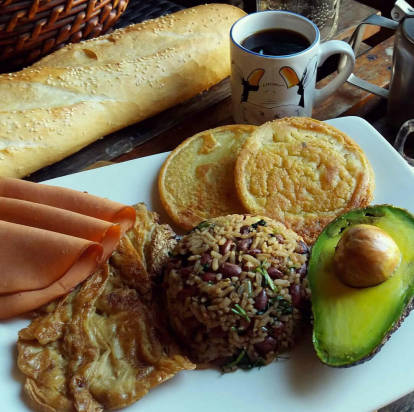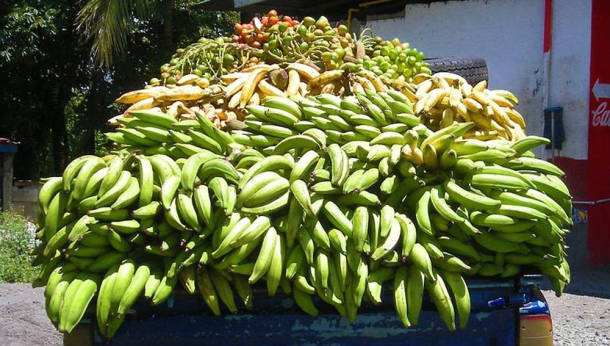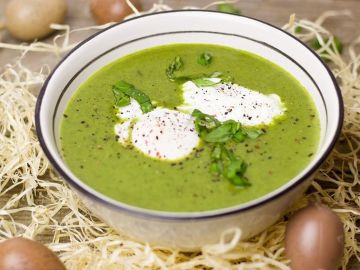What first comes to mind when you think of Costa Rica? For most people, it’s the country’s abundant nature, biodiversity, and beaches, which have led to a boom for ecotourism in Costa Rica.
Costa Rican food doesn’t often rank as highly since many travelers mistakenly imagine Costa Rica as just another Latin American country of burritos, tacos and quesadillas. But, while not overly complex or aggressively seasoned, typical Costa Rican cuisine is refreshing, varied and delicious.
Some of the country’s unique culinary culture stems from combining orchard- and farm-picked native ingredients with flavors from around the world, especially Africa and Spain. On a Costa Rica tour, meals can be just as much a part of your adventure as the activities you have planned.
Here are 10 fantastic foods every traveler should try in Costa Rica, along with recipes for making delicious Costa Rican cuisine at home:
1. GALLO PINTO
Literally meaning “painted rooster,” Gallo pinto is a favorite rice-and-beans concoction that is commonly considered the national dish of Costa Rica.
Ticos (the friendly indigenous people of Costa Rica) usually eat it for breakfast, sometimes with scrambled or fried eggs, but it is an enjoyable food at any time of day.
You will find a flavorful version offered in most Costa Rican restaurants or sodas (local diners). But you can also bring the taste home using the following recipe.
Recipe for Gallo Pinto (serves 6)
Ingredients
2 tablespoons vegetable oil
1 medium yellow onion, finely chopped
1 red pepper, chopped
1 tablespoon garlic, finely chopped
2 cups cooked black beans, drained
½ cup Salsa Lizano
3 cups cooked rice (white, short grain)
½ cup fresh cilantro, chopped
Preparation
1. Pour oil into large pan and place on medium heat. Sauté onion, red pepper and garlic until onions begin to soften.
2. Add beans and Lizano sauce, a classic Costa Rican condiment. (If Salsa Lizano is not available, mix together 1 teaspoon ground cumin, 1 teaspoon ground coriander, ½ teaspoon ground ginger and 3 tablespoons Worcestershire sauce. Add to onion mix before beans.) Let simmer for 5 minutes, stirring from time to time.
3. Fold in the cooked rice, reduce to very low heat and continue to cook, stirring occasionally until all liquid is gone and the mixture is well heated.
4. Sprinkle in cilantro and serve warm.

2. CASADO
What Gallo pinto is to breakfast in Costa Rica, Casado is to lunch: The typical filling, midday meal.
More of a combination platter than a specific recipe, Casado brings together cooked rice and beans (which are sometimes mixed together, but more often served apart) with a green or pasta salad, plantains and, if desired, meat (fish, chicken, or beef).
Other foods may also be served on the side, such as French fries, tortillas with cheese, sliced avocado, eggs, corn, and even picadillo, a vegetable stew. In some sodas, a Casado also comes with a refresco (see drinks below).

3. OLLA DE CARNE
Beef stew a la Costa Rica! This quintessential hearty dish is a weekend favorite throughout the year, prepared both in the home and at local sodas.
Similar to the hearty meat stews found elsewhere in the Americas, olla de carne is a savory celebration of fresh Costa Rican ingredients, including cassava, carrots, corn, plantains, taro root, and other vegetables.
It’s a filling meal all on its own. Despite this fact, it often comes with a side of rice and beans.
Recipe for Olla de Carne (serves 6)
Ingredients
4 cups water
½ lb lean beef, in 3-inch pieces
½ lb lean beef short ribs, in 3-inch pieces
½ lb carrots, chopped
3 corn on the cob, in 3-inch pieces
2 green plantains, peeled and chopped into 3-inch pieces
½ lb cassava, peeled and chopped into bite-sized pieces
½ lb taro roots, peeled and chopped into bite-sized pieces
½ cup potato, chopped into bite-sized pieces
salt to taste
Preparation
1. Heat water over medium flame. Add lean beef, short ribs and salt. Cook for 20 minutes.
2. Add carrots, cobs, green plantains and cassava. Cook for five more minutes.
3. Add taro roots and potato. Cover and cook for 25 minutes over high-medium heat until all the vegetables and roots are soft.
4. Serve hot with a bowl of rice.
4. SOPA NEGRA
For vegetarians or soup-lovers who shy away from heavy meat broths, sopa negra is a delightful, traditional Costa Rican alternative. Anchored around the ubiquitous black bean, it is given freshness and added flavor by the inclusion of onions, peppers and cilantro. Topping it with Tabasco sauce adds a nice little spicy kick!
Recipe for Sopa Negra (serves 6)
Ingredients
1 lb black beans (fresh)
8 cups chicken broth or water or a mix
½ teaspoon salt
1 medium onion, finely chopped
2 cloves garlic, finely chopped
1 small red pepper, seeded and finely chopped
10-12 sprigs fresh cilantro
1 tablespoon vegetable oil
salt and black pepper to taste
6 eggs
1 radish, thinly sliced thinly
1 avocado, thinly sliced
1 dollop sour cream per dish
Preparation
1. Drain beans and, in a large stew pot, add to chicken broth, salt and half of the chopped onion, garlic, pepper and cilantro. (If beans were dried, soak them overnight first.)
2. Bring to a boil, then cover pot, reduce heat to a low simmer and cook for 2½ hours or until beans are nearly soft.
3. Set aside a small quantity of chopped onion and pepper (for garnish) and then fold in the remaining onion, garlic, pepper and cilantro, as well as vegetable oil. Cook for another 30 minutes.
4. Add eggs and hard boil them for the final few 4-5 minutes as a function of how hard you like them.
5. Remove eggs, peel them and add one to each serving bowl of soup.
6. Garnish each bowl with a spoonful of sour cream, a slice of avocado, a few slivers of radish, and a sprinkle of chopped onions and peppers.
7. Warm corn tortillas and white rice are also served as sides for mixing into the soup.

5. CEVICHE
Costa Rica isn’t the only Latin American country with a take on ceviche, the popular marinated raw fish dish that’s served chilled. But Costa Rican cuisine uses a unique blend of ingredients, such as tilapia, finely diced vegetables, lime juice, and cilantro. Ceviche is prepared and served fresh both in restaurants and at roadside food carts, particularly in the country’s coastal areas.
Recipe for Ceviche (serves 6)
Ingredients
1 lb tilapia (or another firm white fish), in 1/2-inch cubes
1 small onion, finely diced
2 cloves garlic, finely diced
1 small hot chilli, finely diced
5 sprigs cilantro, finely chopped
¾ cup lime juice
¼ teaspoon salt
pepper to taste
Preparation
Combine all ingredients. Cover tightly and refrigerate for three or more hours. Serve chilled.
6. CHIFRIJO
Chifrijo is a superb snack food that can also double as a more than filling meal. The name is a portmanteau word that combines chicharrones (fried pork rinds) and frijoles (beans).
The dish is an addictive, savory layer cake comprised of black beans, rice, chicharrones, pico de gallo or tomatoes, and avocado slices, which are often served on a bed of tortilla chips or freshly fried corn tortillas.
Chifrijo is commonly found at local events and farmer’s markets, as well as in Costa Rican restaurants.
7. PLANTAINS
Plantains may look a lot like big bananas. But they are much starchier, not at all sweet, and used quite differently in traditional Costa Rican cuisine.
Rather than being eaten as standalone fruit, plantains are usually fried and used as side dishes in culinary classics like gallo pinto and casado.
They also make great snacks or appetizers when twice-fried to make tostones (which are similar in consistency to homemade French fries) or flattened and deep-fried to create patacones. Both are extra delicious when topped with sea salt and some pico de gallo.
Recipe for Patacones (serves 6)
Ingredients
3 green plantains
1 cup vegetable oil
Sea salt to taste
Preparation
1. Peel and slice plantains into 1/2-inch rounds.
2. Place oil in a very hot pan and heat until it is nearly boiling.
3. Place several plantain rounds into hot oil and cook until light brown, approximately two minutes.
4. With slotted spoon, remove cooked plantains and place on a cutting board covered in parchment paper.
5. Place second parchment paper on top and then, with a second cutting board, press down hard on the covered fried plantain rounds, smushing them without breaking them.
6. Place plantain rounds back in hot oil and fry until golden brown.
7. Remove completed patacones with slotted spoon and drain on paper towel.
8. Repeat until all rounds are cooked. Sprinkle with sea salt.

8. TAMALES
While very similar to the tamale of Mexico, the Costa Rican tamale is decidedly its own thing.
Both are based on the traditional Central American dish, which consists of a steamed, corn-based dough (called masa) stuffed with savory or sweet fillings of meat, cheese, fruit, and/or vegetables.
In general, the Costa Rican fillings may look the same as Mexican ones, but they tend to be more garlicky and less spicy. Also, importantly, the wrapping commonly used by Ticos is a banana leaf instead of corn husks.
Wherever they are made, they’re impossible not to love, whether eaten as a snack or, with a side of beans, for breakfast.
9. TRES LECHES CAKE
Three milk cake is a richly sweet finish to any Costa Rican meal. The cake’s origin is unknown, but it is baked and sold all across Central America, as well as internationally.
No matter where it is found, the dessert is always soaked in three forms of milk: evaporated, sweetened condensed, and heavy cream.
Another common milk-based dessert in Costa Rica is arroz con leche, a mixture of rice and milk flavored by sugar, salt, lemon zest, and cinnamon sticks.
Recipe for Tres Leches / Three Milk Cake (serves 12-24)
Ingredients
For the cake:
1½ cups flour
1 teaspoon baking powder
½ cup unsalted butter
1 cup white sugar
5 eggs, whites only
½ teaspoon vanilla extract
For the milk blend:
2 cups whole milk
1 can (14 oz) sweetened condensed milk
1 can (12 oz) evaporated milk
For the icing:
1½ cup heavy cream
1 cup white sugar
1 teaspoon vanilla extract
Preparation
1. Grease and flour a 9×13-inch baking pan. Preheat oven to 350°F.
2. For the cake, mix together flour and baking powder.
3. Combine butter and sugar and mix until fluffy. Then beat together with eggs and vanilla extract.
4. Blend flour mix with butter mix one spoonful at a time. Pour into banking pan.
5. Bake for 30 minutes at 350°F and then poke holes in surface with fork. Set aside to cool.
6. Combine milk blend ingredients and pour over top of cooled cake.
7. For the icing, whip heavy cream, sugar and vanilla extract until thick. Spread over top of cake.

10. REFRESCOS
A favorite refreshment of locals and tourists alike. these widely available fresh fruit drinks use the amazing tropical fruits growing in abundance around the Costa Rican countryside.
The region’s most popular fruits include cas (sour guava), maracuyá (passion fruit), tamarindo (tamarind), guanábana (soursop), piña (pineapple), sandia (watermelon), mora (blackberry), fresa (strawberry), papaya, mango, banana etc.
You will be given the choice of mixing the fruit– natural fruit is much better than pulp– either en leche (in milk) or en agua (in water). The milk drinks are creamier and thicker, sometimes sweetened with a touch of condensed milk or sugar, while the water-based drinks may also have added sugar.
Other well-loved drinks in Costa Rica include horchata (a sweet beverage made from soaked rice, condensed milk, cinnamon, and clove) and resbaladera (a traditional drink of northern Costa Rica, which is made with barley in addition to rice).
Recipe for Resbaladera/Horchata (serves 12)
Ingredients
1 cup rice
½ cup barley for resbaladera or an additional ½ cup of rice for horchata
3 cups water
2 cinnamon sticks
5 whole cloves
3 cups milk
1 tablespoon vanilla extract
1 cup sugar
1/8 teaspoon nutmeg
Ground cinnamon (optional)
Preparation
1. In a large stew pot, combine rice, barley (for resbaladera), water, cinnamon sticks and cloves. Cook for about 20 minutes over medium to medium-high heat until rice is tender. Set aside to cool.
2. Once cool, remove cinnamon and cloves, and pour rice mixture into a blender. While blending, slowly stir in the milk until smooth. If needed, more milk or water may be added to achieve the right consistency.
3. Strain the mix, add vanilla and sugar, and refrigerate until well chilled (at least 15 minutes).
4. Sprinkle with nutmeg (and ground cinnamon, if desired) and serve with ice.






